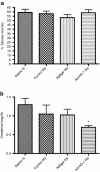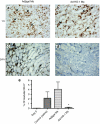Macrophages expressing heme oxygenase-1 improve renal function in ischemia/reperfusion injury
- PMID: 20551909
- PMCID: PMC2956932
- DOI: 10.1038/mt.2010.100
Macrophages expressing heme oxygenase-1 improve renal function in ischemia/reperfusion injury
Abstract
Acute kidney injury has a high mortality and lacks specific therapies, with ischemia/reperfusion injury (IRI) being the predominant cause. Macrophages (M phi) have been used successfully in cell therapy to deliver targeted therapeutic genes in models of inflammatory kidney disease. Heme oxygenase-1 (HO-1) catalyzes heme breakdown and has important cytoprotective functions. We hypothesized that administration of M phi modified to overexpress HO-1 would protect from renal IRI. Using an adenoviral construct (Ad-HO-1), HO-1 was overexpressed in primary bone marrow-derived M phi (BMDM). In vitro Ad-HO-1 M phi showed an anti-inflammatory phenotype with increased phagocytosis of apoptotic cells (ACs) and increased interleukin (IL)-10 but reduced TNF-alpha and nitric oxide (NO) following lipopolysaccharide/interferon-gamma (IFN gamma) stimulation compared to control transduced or unmodified M phi. In vivo, intravenously (IV) injected M phi homed preferentially to the post-IRI kidney compared to uninjured control following experimental IRI. At 24 hours postinjury, despite equivalent levels of tubular necrosis, apoptosis, and capillary density between groups, the injection of Ad-HO-1 M phi resulted in preserved renal function (serum creatinine reduced by 46%), and reduced microvascular platelet deposition. These data demonstrate that genetically modified M phi improve the outcomes in IRI when administered after the establishment of structural injury, raising the prospect of targeted cell therapy to support the function of the acutely injured kidney.
Figures







Similar articles
-
Adoptive transfer of ex vivo HO-1 modified bone marrow-derived macrophages prevents liver ischemia and reperfusion injury.Mol Ther. 2010 May;18(5):1019-25. doi: 10.1038/mt.2009.285. Epub 2009 Dec 22. Mol Ther. 2010. PMID: 20029397 Free PMC article.
-
Enhanced activation of interleukin-10, heme oxygenase-1, and AKT in C5aR2-deficient mice is associated with protection from ischemia reperfusion injury-induced inflammation and fibrosis.Kidney Int. 2018 Oct;94(4):741-755. doi: 10.1016/j.kint.2018.04.005. Epub 2018 Jun 21. Kidney Int. 2018. PMID: 29935951
-
Native macrophages genetically modified to express heme oxygenase 1 protect rat liver transplants from ischemia/reperfusion injury.Liver Transpl. 2011 Feb;17(2):201-10. doi: 10.1002/lt.22214. Liver Transpl. 2011. PMID: 21280193 Free PMC article.
-
Adoptive transfer of heme oxygenase-1 (HO-1)-modified macrophages rescues the nuclear factor erythroid 2-related factor (Nrf2) antiinflammatory phenotype in liver ischemia/reperfusion injury.Mol Med. 2014 Oct 14;20(1):448-55. doi: 10.2119/molmed.2014.00103. Mol Med. 2014. PMID: 25014792 Free PMC article.
-
Therapeutic Potential of Heme Oxygenase-1/carbon Monoxide System Against Ischemia-Reperfusion Injury.Curr Pharm Des. 2017;23(26):3884-3898. doi: 10.2174/1381612823666170413122439. Curr Pharm Des. 2017. PMID: 28412905 Review.
Cited by
-
Renal cells from spermatogonial germline stem cells protect against kidney injury.J Am Soc Nephrol. 2014 Feb;25(2):316-28. doi: 10.1681/ASN.2013040367. Epub 2013 Oct 17. J Am Soc Nephrol. 2014. PMID: 24136918 Free PMC article.
-
Heme Oxygenase-1 in liver transplant ischemia-reperfusion injury: From bench-to-bedside.Free Radic Biol Med. 2020 Sep;157:75-82. doi: 10.1016/j.freeradbiomed.2020.02.012. Epub 2020 Feb 19. Free Radic Biol Med. 2020. PMID: 32084514 Free PMC article. Review.
-
Nitrolipids in kidney physiology and disease.Nitric Oxide. 2018 Mar 29:S1089-8603(18)30006-5. doi: 10.1016/j.niox.2018.03.021. Online ahead of print. Nitric Oxide. 2018. PMID: 29605557 Free PMC article. Review.
-
Biliverdin Reductase A (BVRA) Mediates Macrophage Expression of Interleukin-10 in Injured Kidney.Int J Mol Sci. 2015 Sep 18;16(9):22621-35. doi: 10.3390/ijms160922621. Int J Mol Sci. 2015. PMID: 26393580 Free PMC article.
-
HO‑1 knockdown upregulates the expression of VCAM‑1 to induce neutrophil recruitment during renal ischemia‑reperfusion injury.Int J Mol Med. 2021 Oct;48(4):185. doi: 10.3892/ijmm.2021.5018. Epub 2021 Aug 9. Int J Mol Med. 2021. PMID: 34368855 Free PMC article.
References
-
- Thadhani R, Pascual M., and, Bonventre JV. Acute renal failure. N Engl J Med. 1996;334:1448–1460. - PubMed
-
- Bonventre JV., and, Zuk A. Ischemic acute renal failure: an inflammatory disease. Kidney Int. 2004;66:480–485. - PubMed
-
- Day YJ, Huang L, Ye H, Linden J., and, Okusa MD. Renal ischemia-reperfusion injury and adenosine 2A receptor-mediated tissue protection: role of macrophages. Am J Physiol Renal Physiol. 2005;288:F722–F731. - PubMed
-
- Burne-Taney MJ, Ascon DB, Daniels F, Racusen L, Baldwin W., and, Rabb H. B cell deficiency confers protection from renal ischemia reperfusion injury. J Immunol. 2003;171:3210–3215. - PubMed
Publication types
MeSH terms
Substances
Grants and funding
LinkOut - more resources
Full Text Sources
Other Literature Sources

